Chances to spot Northern Lights increasing for northern U.S. this week

Northern lights erupt above a lake in Northern Minnesota. Getty Images
A series of geomagnetic disturbances that left the sun heading for Earth in recent days could give some residents in the Northern Hemisphere a light show in the form of the Aurora Borealis during the next week.
NOAA’s Space Weather Prediction Center said solar storm influences from what are known as Coronal Mass Ejections (CMEs) and a Coronal Hole High Speed Stream have already reached Earth Sunday, with effects lasting through Friday evening.
Already aurora lights were spotted early Sunday morning in Washington, Wyoming and Maine. Forecasters with the National Weather Service in Riverton, Wyoming shared the photo below of the glowing amber sky taken on early Sunday.
The dancing lights were also seen on the outskirts of Seattle. Skunkbay Weather captured the green hues early Sunday in the video at the top of this story.
A Geomagnetic Storm Watch was issued before the arrival of the event and warned of the potential interference with communication systems and spacecraft operations.
NOAA's SWPC said moderate G2 storms have been observed Sunday and are likely to continue Sunday night into Monday.
If NOAA experts believe the event could be stronger than originally anticipated, the alert could be upgraded to a higher-level warning.
During the most significant geometric storms, widespread power outages are possible, and communication systems are subject to failure.
"Solar magnetic variability regulates the frequency and severity of space weather events and hazards, which can interfere with the electrical grid, degrade GPS signals, increase orbital drag on satellites, and pose radiation hazards to airline crews and astronauts," the SWPC said.
SEE THE OBJECTS HUMANS LEFT BEHIND ON THE MOON
A failure to anticipate the strength of a geomagnetic storm in 2022 was blamed for the loss of more than three dozen SpaceX satellites that became inoperable and burned up in Earth’s atmosphere.
Aurora intensity forecasts are challenging
Space experts admit determining the exact strength of the activity is challenging. However, in this event, NOAA's SWPC expects parts of the globe to again reach at least a Level 6 out of 9 on the Kp Index scale on Sunday night. Already the greatest observed Kp in the past 24 hours was a Level 6 on NOAA's scale, according to the SWPC's 3-day aurora forecast, and aurora were observed early Sunday morning from Washington to Wyoming to Maine.
Later Monday is forecast to drop a Level 3 on the Kp Index scale, indicating weaker activity.
The scale is used to characterize the magnitude of geomagnetic activity, and when values reach at least a 7, cities such as Seattle and Green Bay, Wisconsin, start to see significant chances of witnessing the Northern Lights if skies are clear and light pollution is low.
The University of Alaska Fairbanks aurora forecast shows another spike in Northern Lights activity possible on Thursday night.
Cloud cover can inhibit viewing, and large sections of the northern U.S. are forecast to be under a decent layer of clouds from Monday night into Tuesday morning, as is common during the fall and winter.
Geomagnetic Storms likely to become more frequent
Geomagnetic storms could become more frequent over the next year as the sun begins to move into the solar maximum phase of its 11-year cycle.
A solar cycle is a sequence the sun’s magnetic field goes through every 11 years, where the field flips.

